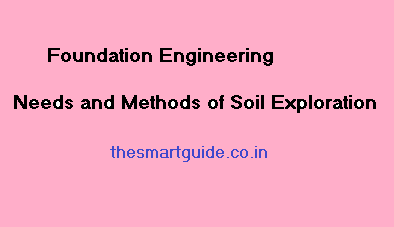Soil Exploration: Soil exploration is like studying soil to understand how to use it better. It helps us learn about its composition and quality for farming and other purposes. It's like unlocking soil's secrets to improve its use.
Need for Soil Exploration:
Soil exploration is essential for:
- To determine the bearing capacity of the soil.
- To determine the suitability of the soil as a construction material.
- optimizing crop productivity and nutrient management.
- Identifying soil contamination and ensuring environmental safety.
- Preventing erosion and preserving land integrity.
- Assessing site suitability for construction projects.
- Evaluating groundwater availability and quality.
- Promoting sustainable land management practices and advancing scientific understanding in agriculture, environment, and geology.
Also, Check Previous Post
Methods of Soil Exploration:
Methods of soil exploration involve various techniques and approaches to study and analyze soil properties. These methods provide valuable information about soil composition, fertility, structure, and other important characteristics.
Various Methods of Soil exploration are:
- Open excavations
- Borings
- Geo-physical methods
- Sounding and penetration tests
Here are some other methods of soil exploration Detailed:
Soil Sampling: Soil samples are collected from different locations and depths using specialized tools such as augers or soil corers. These samples are then analyzed in laboratories to determine their physical and chemical properties.
Field Observations: Direct observations are made in the field to assess soil characteristics such as color, texture, structure, moisture content, and the presence of any visible contaminants or organisms.
Laboratory Testing: Soil samples obtained through sampling are subjected to a range of laboratory tests. These tests include particle size analysis, pH measurement, nutrient analysis, organic matter content determination, and other relevant assessments.
Geophysical Techniques: Geophysical methods like ground-penetrating radar (GPR), electrical resistivity, and seismic surveys are used to study soil properties and subsurface features without physically disturbing the soil. These techniques provide information about soil layers, moisture distribution, and the presence of rocks or other geological formations.
Remote Sensing: Remote sensing involves the use of satellite imagery, aerial surveys, and other remote sensing technologies to gather information about large-scale soil patterns, vegetation growth, and land cover types. This method provides valuable data for soil mapping and monitoring.
Soil Drilling: Soil drilling involves the use of drilling equipment to extract soil cores from deeper layers of the ground. These soil cores provide detailed information about soil profiles, including the composition and arrangement of different soil layers.
Soil Augering: Augers, either hand-operated or mechanical, are used to collect soil samples from shallow depths. This method is commonly employed for preliminary assessments and quick soil sampling.
Soil Pit Excavation: Excavating soil pits or trenches allows for the direct observation and sampling of a vertical section of soil. This method provides a visual representation of soil horizons and allows for detailed analysis.
Soil Moisture Measurements: Various devices, such as moisture probes or tensiometers, are used to measure soil moisture content and monitor changes in soil water availability. This information is important for irrigation management and water resource planning.
Soil Permeability Tests: Permeability tests, such as the constant-head or falling-head tests, are conducted to determine the rate at which water flows through the soil.
These tests help evaluate the soil's drainage capabilities and water-holding capacity. By employing these methods of soil exploration, scientists, engineers, agronomists, and environmental professionals can gather essential data for land management, agriculture, construction planning, and environmental conservation.
Thanks For visiting this page.


Post a Comment